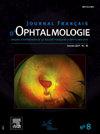Impact of epithelial removal techniques on low contrast acuity after photorefractive keratectomy: A prospective randomized study
IF 1.2
4区 医学
Q3 OPHTHALMOLOGY
引用次数: 0
Abstract
Significance
This study reveals the advantage, in terms of quality of vision, of using mechanical debridement with rotating brushes versus chemical debridement, which has significant, broad practical applications for refractive surgeons, optometrists and patients. These findings may aid all parties in decision-making, as well as influence financial planning and time to full visual recovery.
Purpose
To compare the effect of the rotating brush and ethanol de-epithelization techniques on visual contrast sensitivity after photorefractive keratectomy (PRK).
Methods
This was a prospective, randomized study including myopic patients who underwent bilateral PRK, with one eye de-epithelialized with a rotating brush and the other with 20% ethanol, followed by wavefront-optimized laser ablation. Preoperative, 3- and 12-month postoperative thresholds of low contrast visual acuity were found to be 6%, 12.5%, and 25%, respectively. A nonparametric Friedman and post hoc test was used to compare measurements between the eyes and within-group differences.
Results
The study included 96 eyes. Related-sample Friedman's test showed significant statistical difference (P = 0.004, P < 0.001, P < 0.001, respectively) between all six groups (ethanol and brush groups measured at baseline, 3, and 12 months postoperatively), rejecting the null hypothesis of equal variances. In post hoc analysis 12 months postoperatively between ethanol and brush groups at the 6% threshold, no statistically significant difference was observed; at the 12.5% threshold, a statistically significant difference was seen (P = 0.013), and at the 25% threshold, a statistically significant difference was observed (P = 0.046). A significant difference was observed in the brush group between 3 and 12 months whereas a statistically significant difference was barely achieved in the ethanol group. A significant difference was observed in both groups between 3 and 12 months (P < 0.001).
Conclusion
Both corneal epithelial debridement techniques are safe and effective methods for epithelial removal. Nevertheless, in our study, the mechanical debridement technique showed slightly better results in terms of visual contrast sensitivity during the 12-month postoperative follow-up period.
Importance
L’étude révèle l’avantage de l’utilisation d’un débridement mécanique avec des brosses rotatives par rapport au débridement chimique sur la qualité de la vision, ce qui a une large application pratique significative pour les chirurgiens réfractifs, les optométristes et les patients. Ces résultats peuvent faciliter la prise de décision dans tous les domaines et influencer la planification financière et un calendrier de récupération visuel complet.
Objectif
Comparer l’effet des techniques de brosse rotative et de désépithélisation à l’éthanol sur la sensibilité au contraste visuel après une kératectomie photoréfractive (PRK).
Méthodes
L’étude prospective randomisée incluait des patients myopes ayant subi une PRK bilatérale, avec un œil désépithélialisé par une brosse rotative et l’autre par de l’alcool à 20 %, suivi d’une ablation laser optimisée en termes de front d’onde. Les résultats cliniques préopératoires, à 3 et 12 mois postopératoires ont été évalués aux seuils de 6 %, 12,5 % et 25 % d’acuité visuelle à faible contraste. Un test non paramétrique de Friedman et post hoc a été utilisé pour comparer les mesures entre les yeux et les différences au sein du groupe.
Résultats
L’étude a porté sur 96 yeux. Le test de Friedman a montré une différence statistique significative (p = 0,004, p < 0,001, p < 0,001, respectivement) entre les six groupes (groupes éthanol et brosse mesurés comme référence, 3 et 12 mois après l’opération), rejetant l’hypothèse nulle d’écarts égaux. Dans une analyse post-hoc effectuée 12 mois après l’opération entre les groupes éthanol et brosse au seuil de 6 %, aucune différence statistiquement significative n’a été observée ; au seuil de 12,5 %, une différence statistiquement significative a été observée (p = 0,013) et au seuil de 25 %, une différence statistiquement significative a été observée (p = 0,046). Une différence significative a été observée entre 3 et 12 mois dans le groupe brosse, alors qu’une différence statistique a été à peine atteinte dans le groupe éthanol. Une différence significative a été observée dans les deux groupes entre 3 et 12 mois (p < 0,001).
Conclusion
Les deux techniques de débridement épithélial cornéen sont des méthodes sûres et efficaces pour l’ablation de l’épithélium. Néanmoins, dans notre étude, la technique de débridement mécanique a montré des résultats légèrement meilleurs en termes de sensibilité au contraste visuel au cours du suivi postopératoire de 12 mois.
光屈光性角膜切除术后上皮去除技术对低对比敏锐度的影响:一项前瞻性随机研究
本研究揭示了旋转刷机械清创与化学清创相比在视力质量方面的优势,对屈光外科医生、验光师和患者具有重要的、广泛的实际应用价值。这些发现可能有助于各方的决策,以及影响财务规划和完全恢复视力的时间。目的比较旋转刷和乙醇去上皮技术对光屈光性角膜切除术(PRK)后视觉对比敏感度的影响。方法:这是一项前瞻性随机研究,纳入了接受双侧PRK的近视患者,其中一只眼睛用旋转刷去上皮,另一只眼睛用20%乙醇去上皮,然后进行波前优化激光消融。术前、术后3个月和12个月低对比视力阈值分别为6%、12.5%和25%。非参数Friedman和事后检验用于比较眼睛之间和组内差异的测量结果。结果共纳入96只眼。相关样本Friedman检验显示有显著统计学差异(P = 0.004, P <;0.001, P <;在所有六组(乙醇组和刷子组在术后基线、3个月和12个月测量)之间,分别为0.001),拒绝等方差的零假设。在术后12个月的事后分析中,乙醇组和刷头组在6%的阈值下,没有观察到统计学上的显著差异;在12.5%阈值处,差异有统计学意义(P = 0.013);在25%阈值处,差异有统计学意义(P = 0.046)。在3个月和12个月之间,刷组观察到显著差异,而在乙醇组几乎没有统计学上的显著差异。两组在3个月和12个月间观察到显著差异(P <;0.001)。结论两种角膜上皮清创技术都是安全有效的角膜上皮清除方法。然而,在我们的研究中,在术后12个月的随访期间,机械清创技术在视觉对比敏感性方面显示出稍好的结果。重要的是,“ , ”和“········································································”Ces结果peuvent faciliter la撬德决定在下属分支等影响分为满分规划化夫等联合国calendrier de恢复visuel完整。目的比较交叉旋转法、光敏法、程控法、程控法、程控法、程控法、程控法、程控法、程控法、程控法和程控法的效果。其中,期望值期望值期望值期望值期望值期望值期望值期望值期望值期望值期望值期望值期望值期望值期望值期望值期望值期望值期望值期望值期望值期望值期望值期望值期望值期望值期望值期望值期望值期望值期望值期望值期望值期望值期望值期望值期望值。结果倩碧preoperatoires, 3等12月postoperatoires安大略省的高频安勤科技辅助seuils de 6%, 12日5%等25% d 'acuite visuelle一faible反向风。在此基础上,将非特定的可变因素与特定的可变因素进行比较,将不同的可变因素与不同的可变因素进行比较。rs - 3的寿命为96年。Le test de Friedman a montrest 1差异具有统计学意义(p = 0.004, p <;001, p <;1 . 0 . 001,分别为6组(3组和12组分别为1组和3组、3组和3组、3组和12组)、3组和12组(3组和12组)、3组和12组(3组和12组)。在一个分析因果effectuee 12月两者之间的小组然后l 'operation乙醇等纤毛刷盟seuil de 6%,没有任何用的差异n高频observee;在12.5%的抽样调查中,一个差异统计数据对观察所得的数据具有显著性(p = 0.013);在25%的抽样调查中,一个差异统计数据对观察所得的数据具有显著性(p = 0.046)。有意义的一个区别于高频observee 3到12个月之间在groupe纤毛刷,那么何谓不同statistique疾病一个刑罚atteinte在groupe乙醇。有一个显著的差别,即在两个组中有3个和12个(p <;0001)。结论采用“双技术”治疗与“双技术”治疗相比,“双技术”治疗的效果更好。Neanmoins,在我们练习曲,de la技术清创术mecanique一个装饰音管结果legerement更好的en术语de sensibilite盟反向风visuel分为du suivi postoperatoire de 12月。
本文章由计算机程序翻译,如有差异,请以英文原文为准。
求助全文
约1分钟内获得全文
求助全文
来源期刊
CiteScore
1.10
自引率
8.30%
发文量
317
审稿时长
49 days
期刊介绍:
The Journal français d''ophtalmologie, official publication of the French Society of Ophthalmology, serves the French Speaking Community by publishing excellent research articles, communications of the French Society of Ophthalmology, in-depth reviews, position papers, letters received by the editor and a rich image bank in each issue. The scientific quality is guaranteed through unbiased peer-review, and the journal is member of the Committee of Publication Ethics (COPE). The editors strongly discourage editorial misconduct and in particular if duplicative text from published sources is identified without proper citation, the submission will not be considered for peer review and returned to the authors or immediately rejected.

 求助内容:
求助内容: 应助结果提醒方式:
应助结果提醒方式:


